Alan Robert Horvath (1952-2010)
Kirpan Press, Through My Eyes by Kathy Horvath
Alan Robert Horvath (1952-2010)
Kirpan Press, Through My Eyes by Kathy Horvath
Alan had several presses in the past: Falling Down Press (1975 – 1976, Cleveland), Mostly Broken Scabs Press (1977 – 1984, Cleveland & San Francisco), F**K IF I KNOW PRESS (1984 – 1998, San Francisco, Fremont, CA) and his last press Kirpan Press (1998 to 2010, Vancouver, WA).
Birth of Kirpan Press
Alan describes how Kirpan Press originated in a two-part online interview with Bob Holman in About.com, titled “Keeper of the Mimeo Flame and the Flaming Mimeo.” For the complete two-part interview please follow this link.
From the article, Alan wrote:
After not publishing for 13 years, I was pulled out of retirement when I attended a poetry reading at a bookstore in Kent, Ohio. Besides starting to resurrect partial books that had been dormant for 20 years, Dave Pishnery motivated me to dig through the scraps of poems I had written in the 1980s. The result was the co-authored & co-produced book: Surfacing.”
In Alan’s discussions with an East Indian friend about his Sikh religion, the friend described a kirpan as a Sikh ornamental dagger which represents that a person should be equal parts “soldier” as well as “saint.” Alan thought this means attaining a balance within the soul. Kirpan Press was the chosen name for his last small press.
Staff
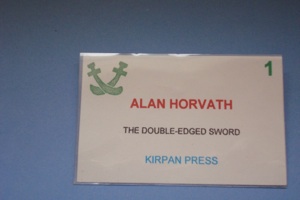
Kirpan Employees
Alan, The Double-Edged Sword
Kathy, Master Binder / The Wall Which Everything Bounces Off
Dave Pishnery, Research & Recovery
Julie, Reproductionist Extraordinaire
Dark-Haired Lady, Preferred Mail Clerk
Kent Taylor, Sr. Foreign Correspondent / Main Archivist
Jim Lowell, Commander & Chief
Tessa Lowell, Survivor / The Warmest Soul
Sandie Sigmund, East-Of-The-Mississippi Distributor
ISIS (Ingrid Swanberg), Archivist / Historian
Nancy Birk, Main Archivist / Chief Indian Fan
Richard Werner, Minister of Culture
rjs, Captain Zero / The Source
Tom Kryss, Art Direction / Inspiration
Karl Young, Art Direction / Inspiration
Mark Solars, Staff Writer / Contributor
Cindy Marx, Official Kirpan Press Photographer / International Kirpan Press Book Seller
Jake Marx, Senior Staff Poet / Teacher / Keeper of the Lowell Spirit
Julie, who worked at the Copy Max in Portland, did an amazing job copying the levy collages, paintings and other artwork. Alan waited till she was on duty so she could work her magic.
Equipment & Supplies Used
Inkjet BJC 70 color printer
Canon or Panasonic photocopiers
HP LaserJet printer
Ibico comb binding machine
Needle nose pliers
Heavy duty stapler
Comb Bindings
“Do Not Bend” and “Fragile Stickers”
Research and Editing
Alan continually thought about material that would make a good publication. Surfacing was the first Kirpan Press book, published in 1998. Starting in the late 90s, we visited Cleveland and sought out d.a. levy material, in preparation for his levy series, at Kent State’s Special Archives, and the Cleveland Public Library.
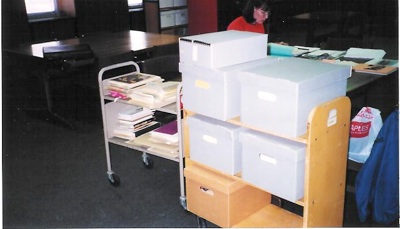
In all, Alan published 22 volumes of levy materials. Before Alan and Kent Taylor met, Kent Taylor was interested in updating Jim Lowell’s levy biblio which initially appeared in Kent State’s serif. Ingrid Swanberg gave Kent’s name to Alan, and on 2/7/2000 Alan wrote to Kent asking “how could I help?” This led to their collaborative effort to publish Looking For d.a. levy – the d.a. levy Bibliography – Volumes 1 and 2. The biblio is posted here.
Alan kept all correspondence and some envelopes he received over the years. Being a letter writer himself, he believed correspondence would be insightful to the reader; he obtained and published a multitude of levy correspondence with various people. Three publications were also issued which contain correspondence between Jim Lowell, Kent Taylor and Tom Kryss.
When publishing poetry, he contacted the author, discussed his idea with them and asked them to send some poems. He made his selection and, if necessary, might ask for anything additional he thought was needed for the book. He retyped the poems, since he usually did not receive any word documents on a disc. He might make spelling changes but told the person what he planned to change. He asked if they had a title in mind, but suggested something if he thought it more appropriate. In the end, he deferred to the author.
He chose the color and texture of the paper and interspersed any image he felt was needed like a Tom Kryss silkscreen or rjs collage - or a photograph of the author. He put one copy of the poems/illustrations in order and bound an alpha copy that he could take some time with to make sure things were as he wanted. The best place to buy paper in the Portland/Vancouver area is a store called The Paper Zone. The store discontinued some of Alan’s favorites, but continued carrying others, such as Green Tea and started stocking paper and envelopes in unusual and vivid colors. We usually went to the store when they had their 20% off sale. If the book was going to be comb-bound, he decided on the size and color of the comb. Kirpan Press covers were either stylized images of Alan’s photographs or artwork contributed by others including Karl Young, Richard Werner, Tom Kryss, Kent Taylor, Dave Pishnery, Jim Clinefelter and Mike Schaefer.
Photographs included a Cindy Marx photo of Jim Lowell’s writing desk in Notes to Cleveland: Correspondence from Jim Lowell to Tom Kryss (1979-2003), B.L. Kennedy’s photo of Grace Butcher used in Horses In The Snow, and the Polaroid of Joan and her son, Joey, who Alan encountered on a camping trip and writes about in his book Until The Last Light Goes Out.
Production
I read levy’s early lyrical poetry for the first time as I was typing the first few books. As Employee #2, I typed, proofed, gave a little help with grammar, helped to staple and glue, punched and comb-bound, and was the “wall that everything bounces off of.” We worked together to copy illustrations or concrete poetry, normally having to reduce, darken, lighten and reposition the image – up, down, left, or right. We grew faster with this over time. After we made copies, I whitened out all the speckles with Alan’s guidance and this became the master. He calculated how many reams of paper he needed for copying and tried to use cover and paper stock or illustrations that he’d held onto for years.
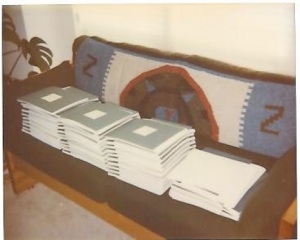
On Fridays, I brought home the comb-binding machine I had at work since it wasn’t being used, and no one would miss it. I punched and comb-bound the books and we worked in tandem if there were inserts of a different size he needed bound in.
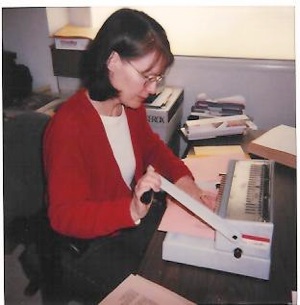
If Alan stapled a book, he rigged up a “template”, so to speak, with masking tape, positioned on an underlying book that served as a guide to where the book was positioned so that the staples were placed in a consistent manner. If the cover stock was susceptible to finger prints, I used medical gloves so I didn’t leave fingerprints. After it was stapled, he used a pair of needle-nose pliers to flatten the back of the staples so the books stacked better.
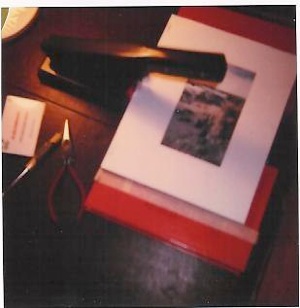
In Kent Taylor’s book Days of Endless Nights which has a glued cover, three different types of glue failed to hold until we successfully used rubber cement with the strongest fumes. So we glued the books in the open air, going to Vancouver’s historic reserve which was established as a fur trading post for Britain’s Hudson’s Bay Company in 1825. This park like atmosphere provided a nice break since we were there for a number of hours listening to music and watching people with their kids or pets. When we arrived home, he added a weight on top of the books until the glue dried. After the books were finished (to Alan’s relief), we boxed them up, and labeled the box. When he received an order, I pulled the books, Alan packaged them and I took them to the post office. He kept track of the number of copies remaining for each publication.
Alan had the vision to include many quirky treasures in his publications. In The Clevelanders, Vol. III, a small piece of paper was glued to the inside back cover full of pencil point sharpenings from his Ferguson work as an instrumentation designer. A small pair of scissors was included in an envelope labeled “Your Editing Tool.” An application to become an Illegal Alien was included at the back of Measured Steps along with an Illegal Alien Face Mask made from dust saved from his apartment in Cleveland. Measured Steps was wrapped in aluminum foil - he said people could make the decision to unwrap it, if they chose to do so. During Dave Pishnery’s visit in 1998, we cut red and green cellophane squares and glued them over cutouts - entitled “eyes of cleveland” in Survivor’s Desk Reference (To The Modern World) which added to the hand crafted feel of the book.
Alan always liked having a secure mailing address – a post office box. He enjoyed the anticipation of checking the box on Tuesdays, Thursdays and Saturdays. Before we arrived at the post office, he asked me how many pieces of mail would be in the box. Something of interest usually arrived, not every time but, when it did, there might be 1, 2 or 3 pieces. When he received an order, he promptly packaged the books and mailed them. He used sturdy boxes from The Paper Zone and prevented the contents, especially the corners, from being damaged by wrapping the books in saran wrap and adding packing peanuts, etc. When he issued an invoice on a book order, he established account names: among them “across the pond”, “toy boat”, “photo eye”, and “play really fast” – geared towards the individual and demonstrates the playfulness of his character.
Under Kirpan Press, he started producing fliers advertising and describing each book in a clever way, incorporating a reduction of the cover image at the top of the flier. This gave the recipient an idea of what the book was about. He printed the fliers with his color Inkjet printer.
Stories from “The Flats” Broadside Series #1 and 2
In 2007, several people that were important in Alan’s life died. In order of death, this included his aunt Elsie, his mother Dorothy, Alan’s friend of 40 years Mike Puflea, and my mother Dorothy and his uncle Bob shortly thereafter. This prompted Alan to write and publish the precursor to the Broadsides, “Counting Them Down.“ I didn’t know what a broadside was at that point. He glued a red fall leaf to the broadside that we had gathered that fall.
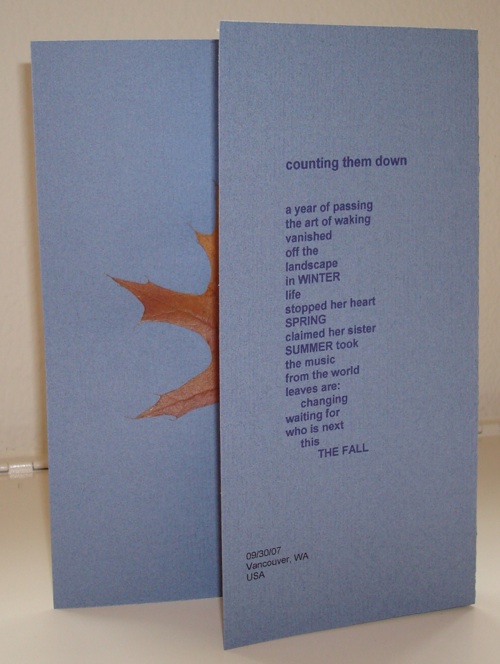
A Charles Olson poem was the first broadside published. As Tom Kryss recounts in his essay in this memorial, a Charles Olson poem was left out of one of Jim Lowell’s Asphodel Catalogues, so Tom and Alan thought that it would be an appropriate choice. Alan generated the rest of the broadside series which included poetry, photographs, collages... He either requested something or chose it from unsolicited poems he routinely received from various people. Alan produced from 75 to 100 copies of the broadsides and sent some copies to the author to be signed.
Alan became interested in rubber stamping during this period, challenging him to find the right image for the broadside and envelope, appreciating the variety of the colored inks. Many of the broadsides were published as a united effort of Kirpan Press and Black Rabbit Press, with Tom Kryss either hand-painting or rubber stamping the broadside and envelope. Alan sealed the envelope so the recipient would have the opening of the envelope as the first step. He used his color Inkjet to print the series.
The last 4 broadsides that Alan was scheduled to produce will be issued In Memoriam.
Other Collaborations
Dave Pishnery produced the cover artwork for Surfacing and visited us in Vancouver in 1998, to help collate the book. We cut 8-1/2” x11” leaves from 24”x36” decorative paper, which was labor intensive but added to its beauty. We took breaks though to watch a Bukowski or Chet Baker video.
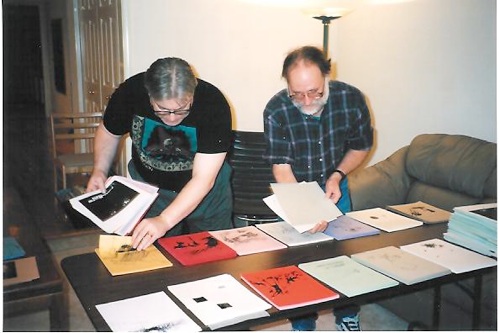
Mike Schaefer had previously provided silkscreen and woodblock artwork covers which Alan had used in the past and continued using on Kirpan Press books such as Variations on Flip, Random Sightings (The Egyptian Stroboscope Sessions), Survivor’s Desk Reference (To The Modern World), Scissorspaperglue, and Measured Steps.
Insights
•Alan preferred to remain small and produce something with human hands. He never applied for a grant or funding.
•Alan didn’t believe in “how to” books and thought it best to figure out the art of writing and publishing on your own, by trial and error.
•Alan felt that if you have to explain what the poem is about, you didn’t do your job in writing the poem.
•Alan was passionate that the words used be easy to understand. At the time, we enjoyed eating out for breakfast, and Alan took poems he’d received to read at the Sheri’s Restaurant in Vancouver. Alan said to me that if I didn't understand a poem, it was not necessarily my fault but that the poet hadn't conveyed it in ways that I could understand.
•I saw that Alan was generous, thoughtful and supportive towards others.
•Alan admired his fellow publishers who issued their publications without any financial assistance.
•Alan was thankful to Jim Lowell and others for their encouragement over the years.